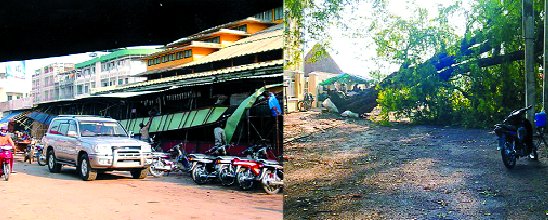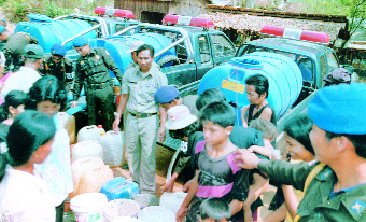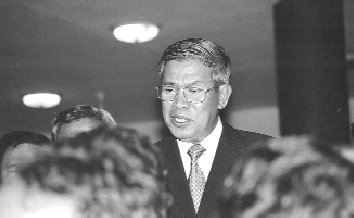| MEET WITH GOD |
PHN@M - P@NH - P@TINS | RENCONTRER DIEU |
Rithia : See what I've found about Cambodian hawks :
by Dick Lohuis : Following independence on 9 November 1953 the Royal
Cambodian Air Force was established with French support on 1 April 1954.
Backed by the French Air Force in Kampuchea, as the Kingdom of Cambodia
was called in those days, the air arm had gained some flying experience
on four MS.500 Criquet aircraft for training
based at Kratie. A DC-3 Dakota was presented
by the French. The government subsequently bought a Cessna 170 and two
Cessna 180.
The new air arm ordered seven Toyo-built Fletcher FD-25A Defender two-seat
and FD-25B single-seat aircraft from Japan
in January 1954. The main base of the Royal Khmer Aviation was established
at Pochentong, near Phnom Penh and during 1954 Cambodia ordered seven Morane
Saulnier MS.733 Alcyon three-seat basic trainers from France. A
follow-on order was placed for eight Alcyons for delivery in late 1955.
Additional types obtained from France during 1955 included one Cessna 170
and three more MS.500 Criquet. A number of US aircraft
were obtained during 1956-57, including eight Cessna L-19 Bird Dogs, 14
T-6G Texans plus five Douglas C-47 and two
de Havilland L-20 (DHC-2) Beavers with which
to equip a small transport element. The increasing conflict in Vietnam
lead to the acquisition of the first helicopters for the Cambodian Air
Force with eight Sud Alouette IIs and two
Alouette IIIs from France in 1960. The first
jet trainers were supplied by France with the delivery of four Fouga
CM170 Magisters in September 1961.
Prince Sihanouks leaning to the US lead to the delivery of 16 North American
T-28Ds in August 1962. In March 1963
the US donated four Cessna T-37Bs to back the Alcyons of the air academy
and two Sikorsky H-19s.
Change of policy turned the Americans away and help was sought in Russia,
resulting in the delivery of two IL-14s, three
An-2s and an Mi-4. In November 1963, the first
of three MiG-17 arrived, together with one MiG-15UTI and one Yak-18.
A follow on batch of nine MiG-17s came a year later. Backing was also sought
in Peking and by the end of 1964, China
supplied additional MiG-15UTI and six MiG-17s followed by five An-2s in
1965. Further help consisted of Chinese engineers constructing a new
runway at Siem Reap.
French support came in March 1964 with six Dassault
Flamant aircraft and four ex FAF Douglas AD-1 Skyraiders.
One year later 10 more of these attack aircraft were presented by the French
to augment the first batch and three defected South
Vietnamese examples. In the late sixties the remaining 15 Alcyon
trainers were replaced by 16 Gardan GY-80 Horizons.
In 1969 the USA started bombing suspected Communist
base camps in Cambodia. Shortly after Prime Minister Norodom
Sihanouk was overthrown by an Army coup in 1970, American and South Vietnamese
troops invaded the country to root out Vietnamese Communists. General Lon
Nol took power and declared the state as Khmer Republic and Sihanouk exiled
to China. A total of 11 new Gardan GY-80 Horizon trainers were taken in
service but the Khmer Air Force was in a poor state of operational capability.
The Cambodian Air Force was backed now again with US assistance and under
operation 'Flycatcher' the service was modernized. It started in 1971 with
the delivery of six Australian and four USAF C-47s. Among other additions
were an alleged batch of some 17 Fairchild C-123K Providers, a squadron
of Cessna T-41D Mescalero and 34 Bell UH-1Hs.
Khmer Rouge - The 1970 invasion managed to push Cambodia's indigenous
leftist guerrillas, the Khmer Rouge ('Red Khmer' in French) into the country's
interior. Savage fighting soon engulfed the entire country, ending only
when Phnom Penh fell to the Khmer Rouge on 17 April 1975. Subsequently
the Khmer Republic was renamed Kampuchea. The collapse of the Cambodian
government saw the fleeing of more then 100 aircraft to Thailand.
Khmer Rouge forces captured the US ship 'Mayaguez',
prompting US retaliatory action which resulted in the successful re-possession
of the ship and its crew. In attacks by the US Navy as many as 17 T-28s
were destroyed thereby neutralizing the Khmers air power in August 1975.
The Air Force ceased almost to exist with the majority of aircraft destroyed
or having fled to Thailand.
Support for this regime came from China
and 16 crated Shenyang F-6 were delivered
in 1977. Six were assembled and formed the first combat squadron of the
Khmer Rouge Air Force at Kompong Chnang. At the end of 1978, Vietnam
invaded Cambodia and overthrew the Khmer Rouge. Much of the Khmer Rouge
Air Force equipment was carried of to Vietnam.
Reform - The Air Force was reformed in 1979 and help
was sought again in Russia. During the late 1970s and throughout the 1980s,
the Khmer Rouge, armed and financed by China and Thailand (and with indirect
US support), fought a guerrilla war against the Vietnamese-backed government
in Phnom Penh. In 1986 the Air Force bought 22
second-hand Russian MiG-21s to form Unit 701 at Pochentong.
The MiGs serials consist of four digits starting with 71 (reflecting the
date when Pol Pot was ousted; 7 January 1979). Operations with the MiGs
didn't last long as help from Russia stopped in 1989 and the lack of spare
parts and support finally grounded the MiGs with the last flight on 17
June 1992.
Organisation - A Helicopter Squadron was formed in 1992 with
a number of Mi-8 and Mi-17.
After the UN monitored general elections of 1993 Norodom Sihanouk
was re-instated as king. The present name of Royal Cambodian Air Force
was adopted and a new roundel was introduced. After all the changes of
government each time a new flag and roundel were introduced but they all
had in common a variation of the Angkor temple. Two Harbin Y-12 and three
BN-2 Islander were taken in service to back the three former Kampuchea
Airlines An-24RV and Beech 200 of the VIP Squadron
in 1993. To fulfil the need of training its own pilots six Tecnam
P92 Echo 3 trainers were ordered in Italy. After delivery they formed
the newly established Reconnaissance Squadron in 1995.
In 1996 a deal was made with Israeli Aircraft Industries
for the overhaul of 12 MiG-21s and part of the deal was the acquisition
of six overhauled Aero L-39C Albatros'. These Czech built trainers were
delivered to Cambodia in 1996-97. The World Bank
and especially the US cut direct foreign aid to Cambodia in mid 1997
after Hun Sen ousted coalition partner Prince Norodom Ranariddh. This also
affected the RCAF deal with Israel as already four MiG-21s were
sent to the IAI Lahav division and Cambodia was unable to pay for the work.
Also in 1997 the VIP Squadron was taken out of the Air Force and put under
governmental control in the Council of Ministry and took with it the Beech
200, C-402 and C-421. France
donated two AS350B Ecureuils, an AS365 Dauphin, a Falcon 20E and a Fokker
F-28 for VIP transport. All this left the Air Force with the regular transport
aircraft of two An-24RV, two Harbin Y-12 and two Islanders and they formed
the Transport Squadron. In 1998 the Ministry
of Defense obtained two Mi-26 helicopters
flown by pilots of the Helicopter Squadron. Eventually these helicopters
will pass on to the Royal Cambodian Air Force.
Future - The will of the country to put former Khmer Rouge leaders
for trial and to reform the economy, led to an agreement with the IMF
for a loan of $80 million in August 1999. Present situation of the RCAF
is that the majority of planes and helicopters have not flown in years
and that the lack of funds for the Air Force puts its toll on it. In February
2000 a MiG-21bis (7102) and MiG-21UM
(7114) returned from Israel after being overhauled. Due to lack of
money and skilled personnel it is still not clear that these aircraft
will see the air again. Cambodia is trying to save money by cutting the
middle man IAI as they are hiring expertise from the Ukraine and
make a deal with this country in the future.
Locations - All the aircraft of the Air Force are based at Phnom
Penh Airbase, formerly known as Pochentong airbase. Other air bases like
Battambang, Siem Reap, Kompong Som, Kampong Chnang, and Koh kong do not
enjoy based aircraft.
| 1) La station de télévision nationale à Pursat, frappée par la foudre, tombait en panne pendant 20 heures. |
|
 |
|

[Koh Santepheap] |
|
On peut remarquer
la disparition des arbres. 
[Radio Free Asia] |
 |


Preah Bat Dhammik Mgr du Mont-Casse-Bois : Je vous bénis, Samdech Premier Ministre! Maintenant, comprenez-vous l'écologie? Quand il n'y a plus d'arbres, la chaleur et la sécheresse sont plus grandes, les pluies et les tempêtes sont plus violentes! Hun Sèn, chef des 5 000 voleurs : Dis donc, espèce de clown d'opéra! Je suis Docteur Honoris Causa d'innombrables universités! |
|
|
|
|
|
|
|
( PREVIOUS ) |
|
|
|
|
|
|